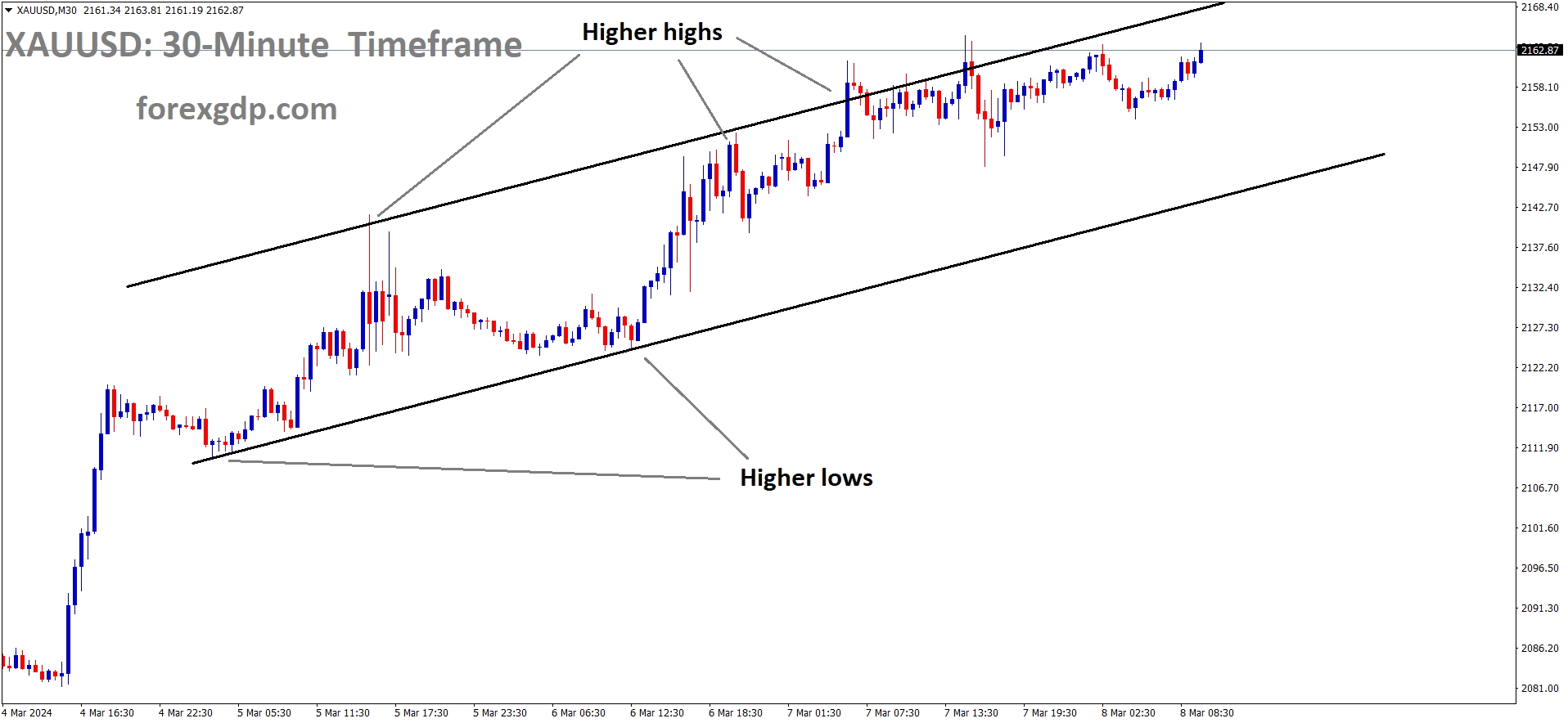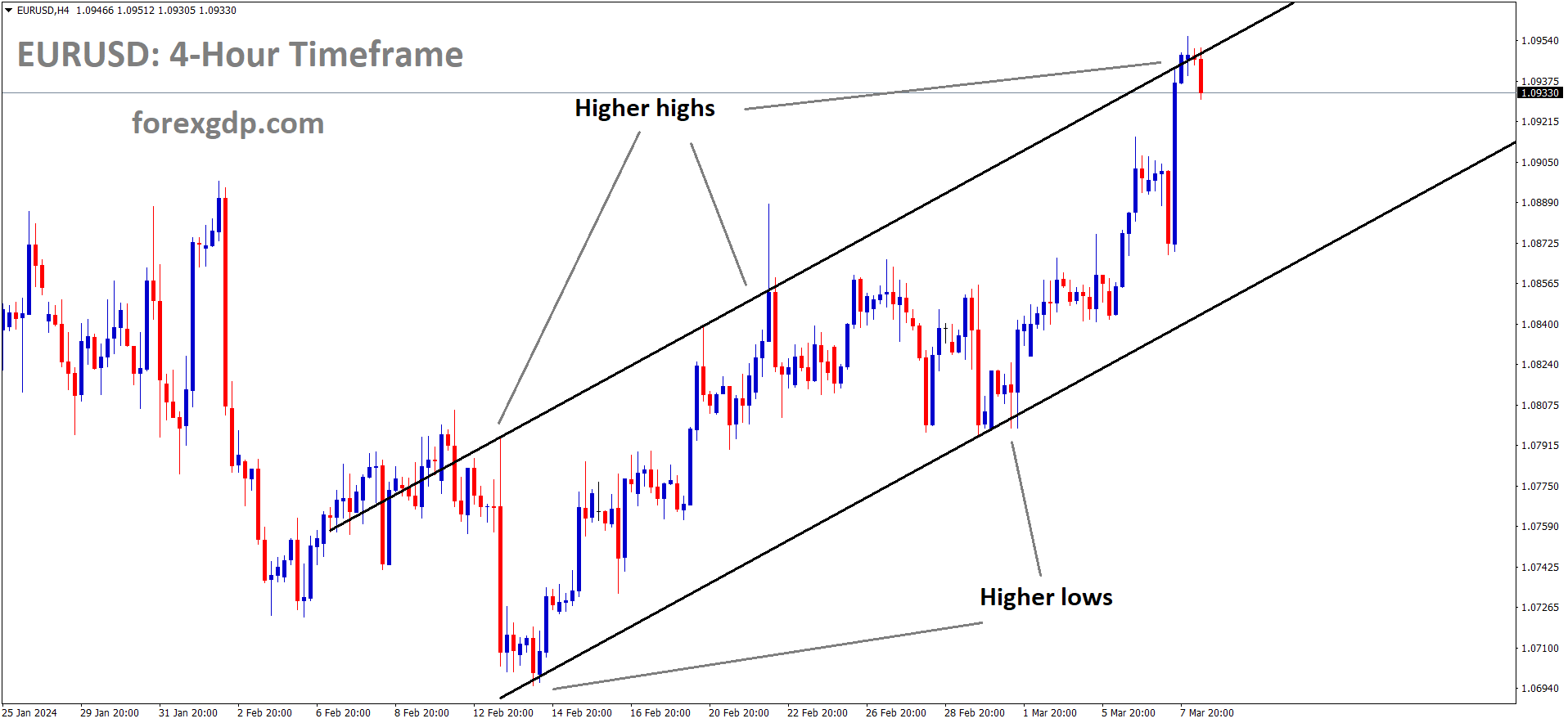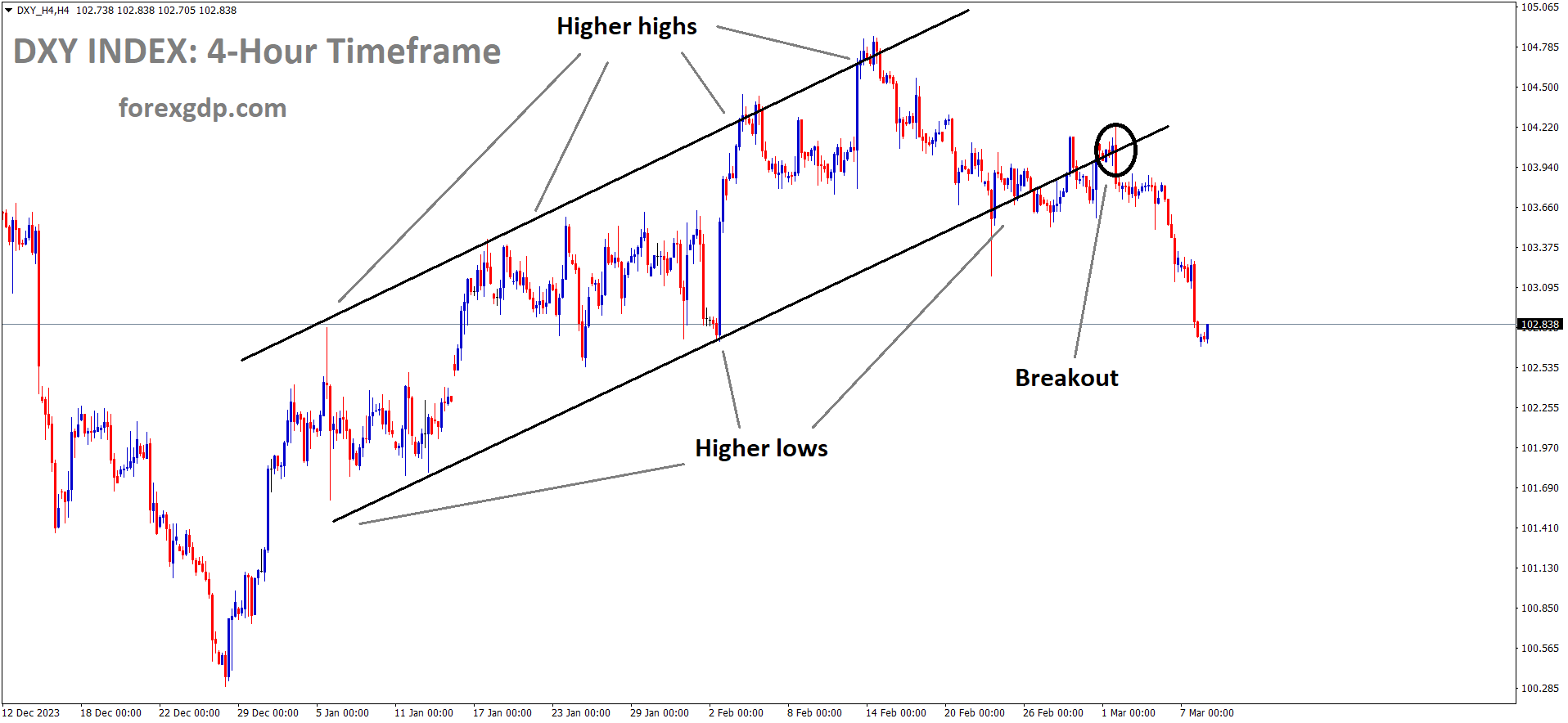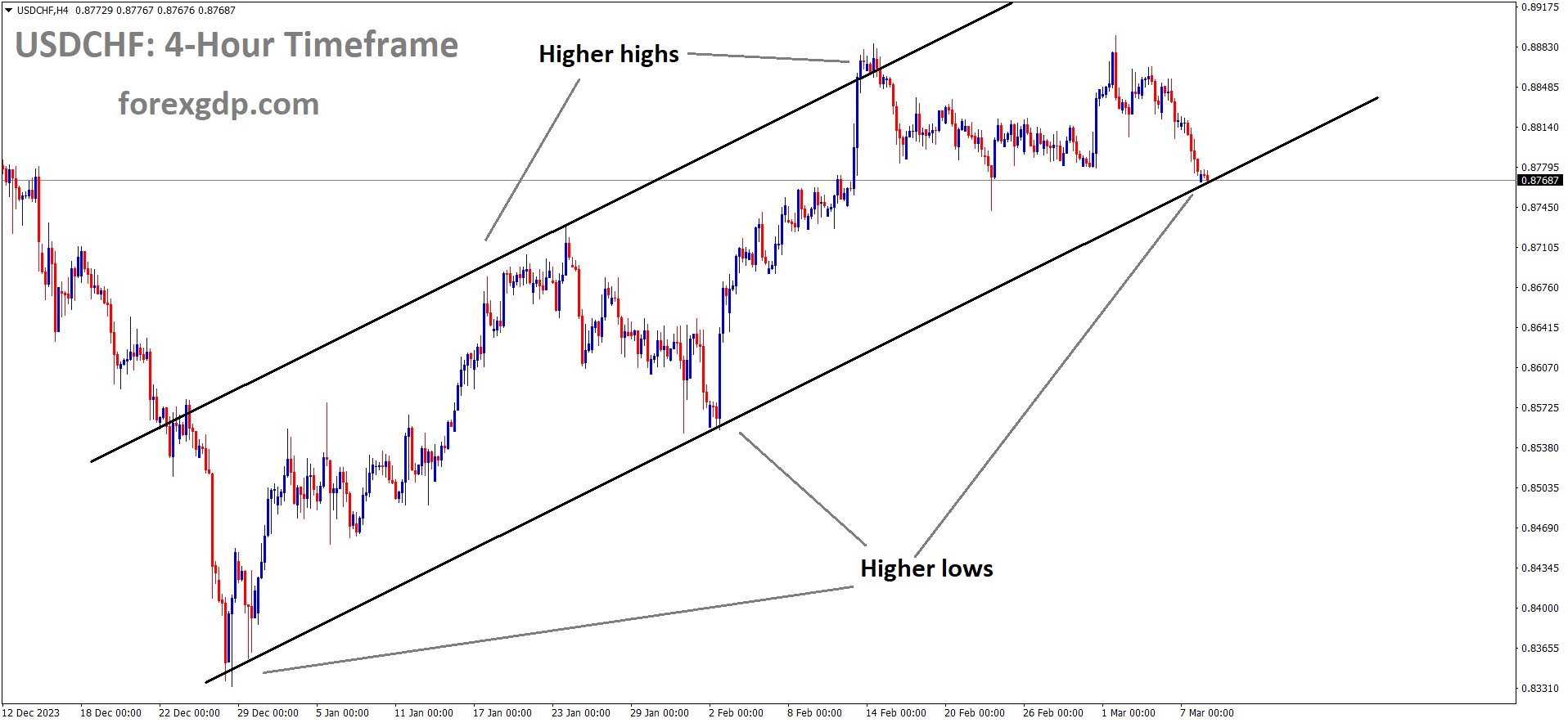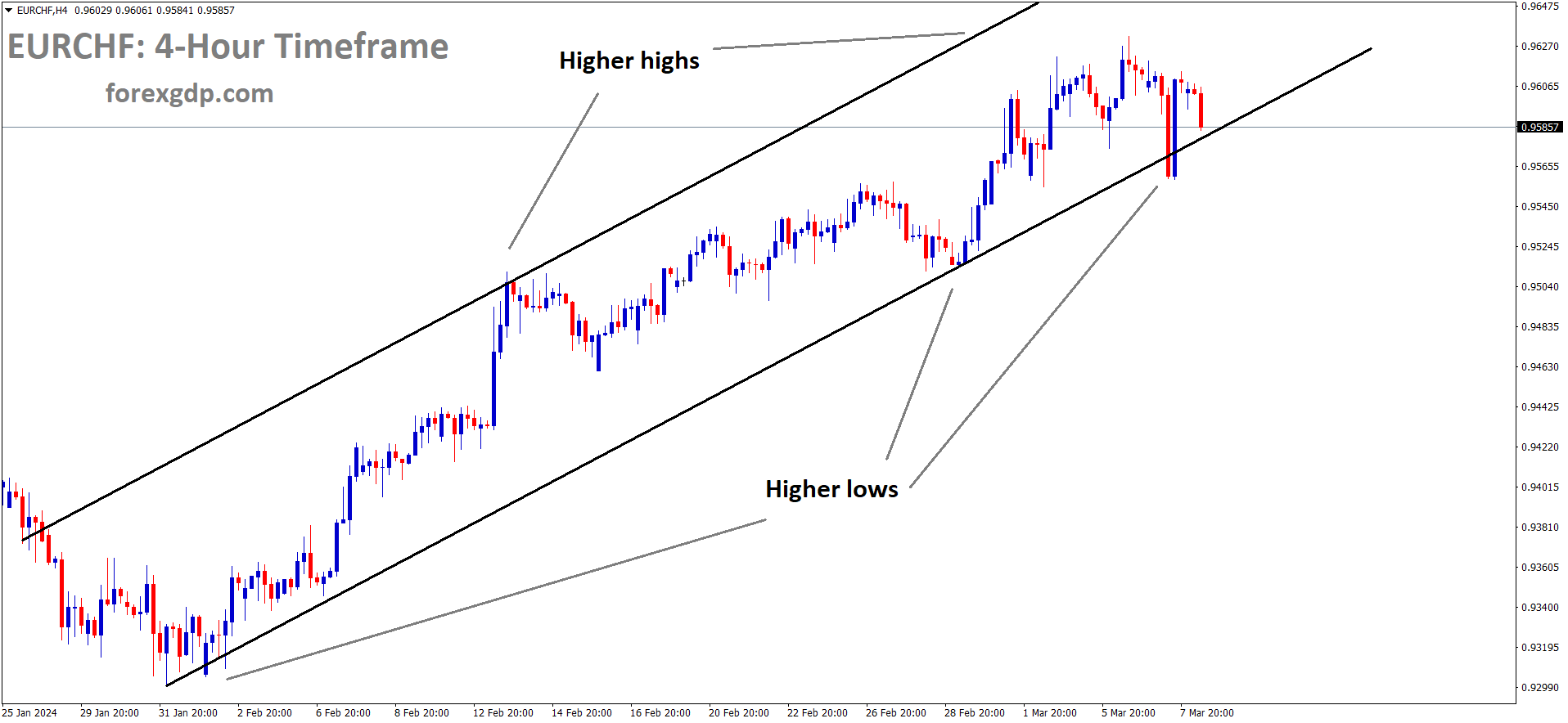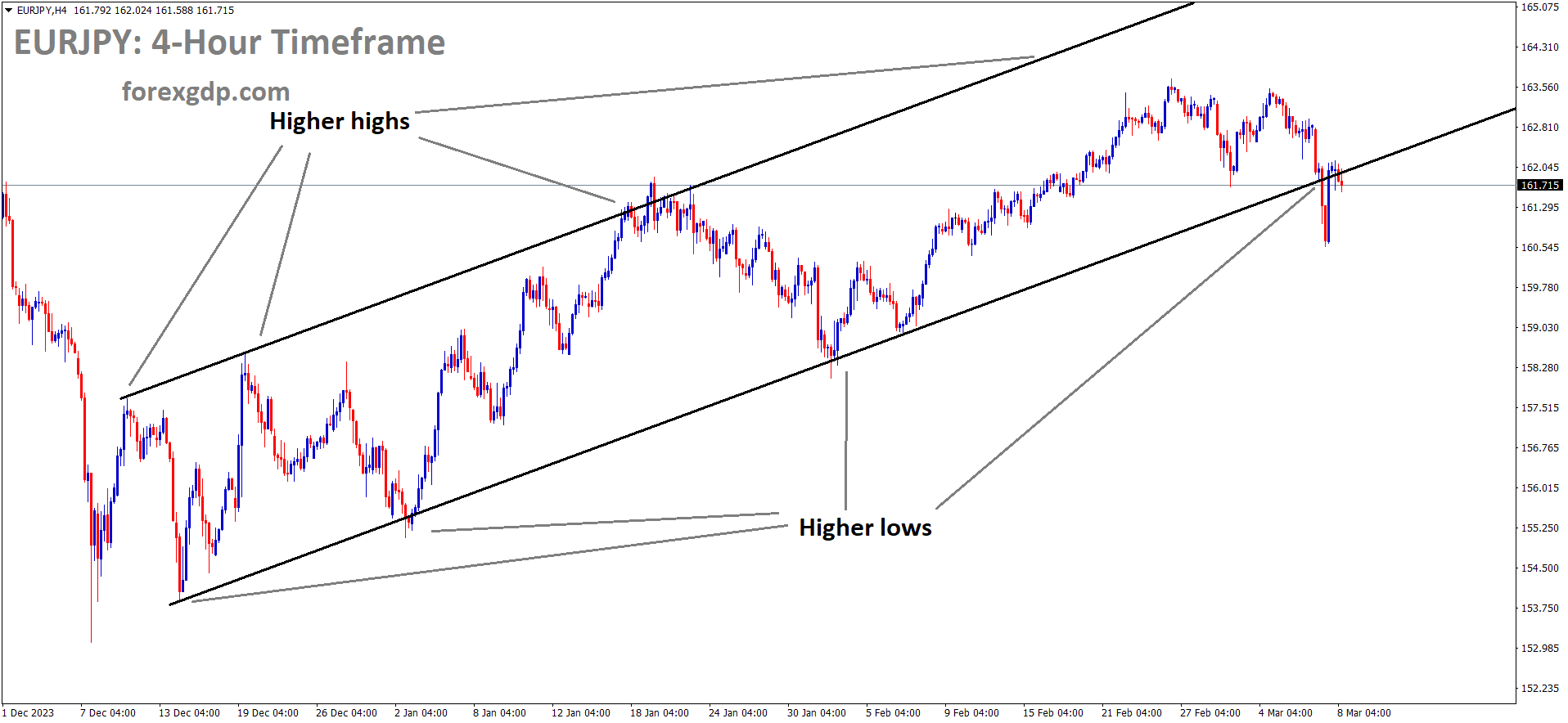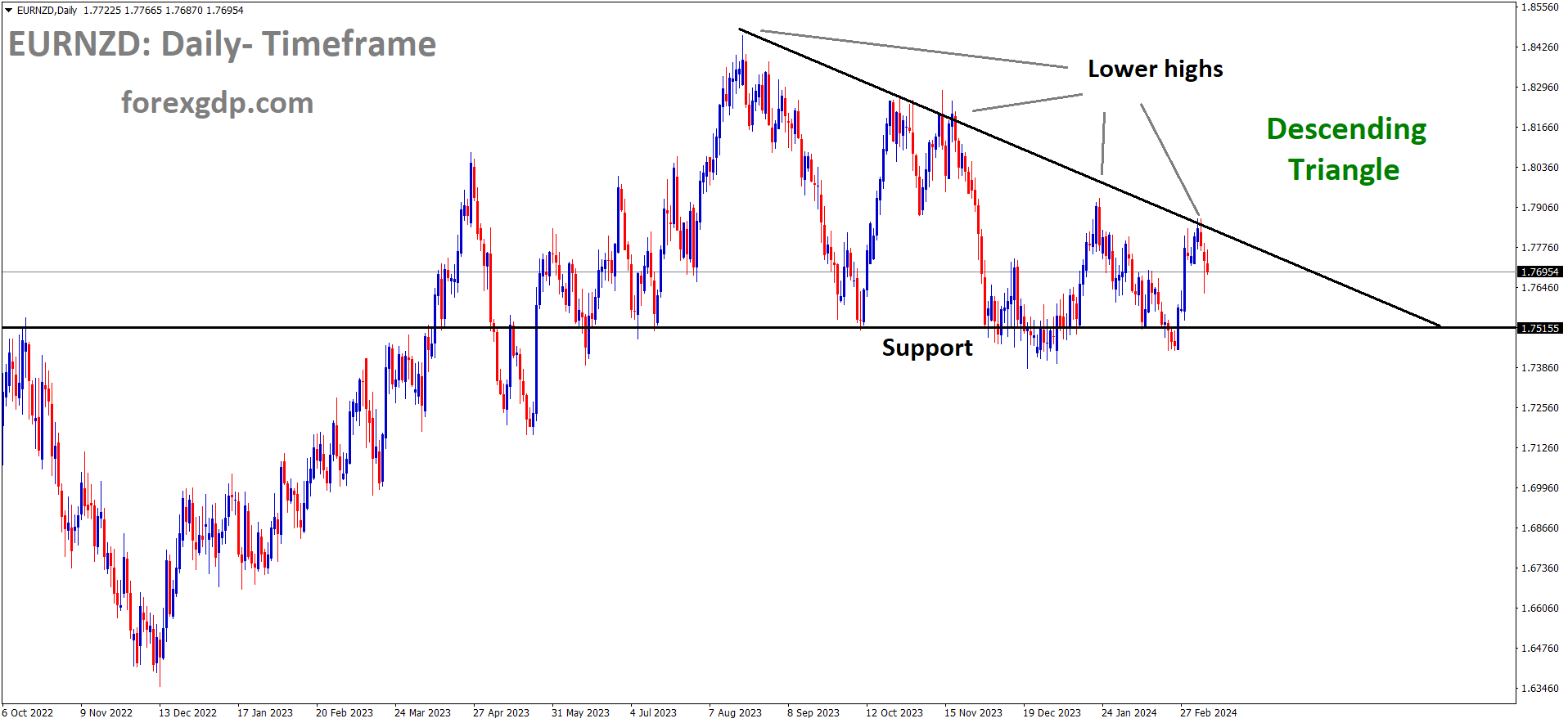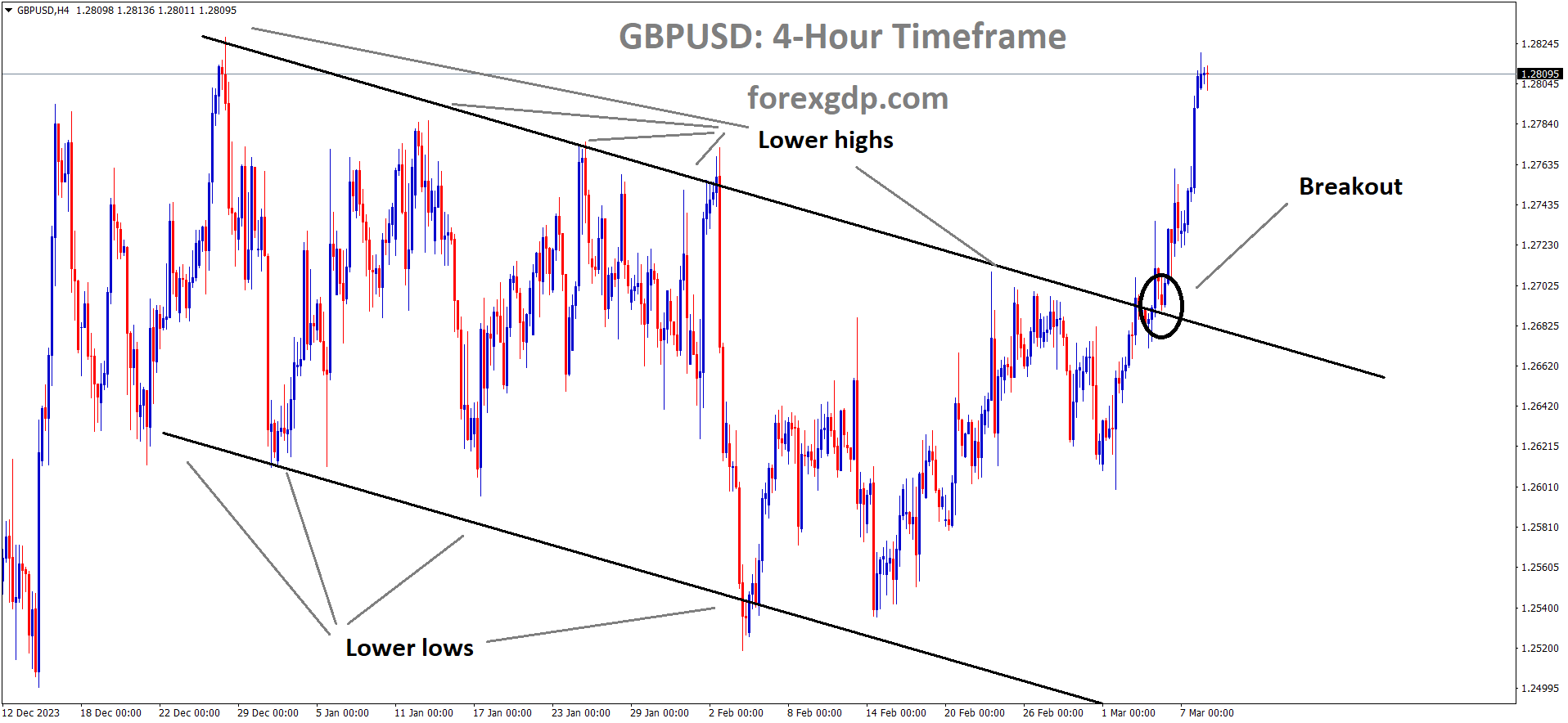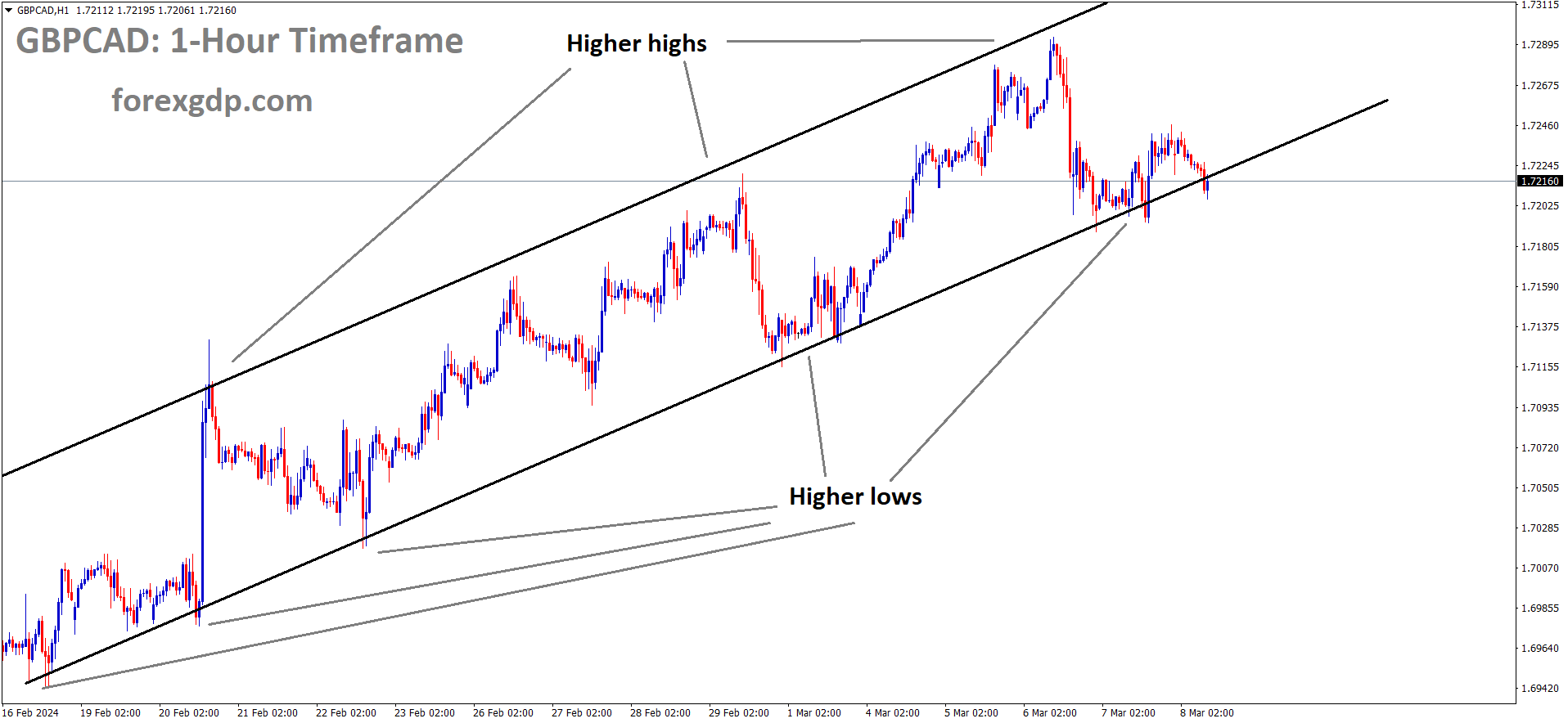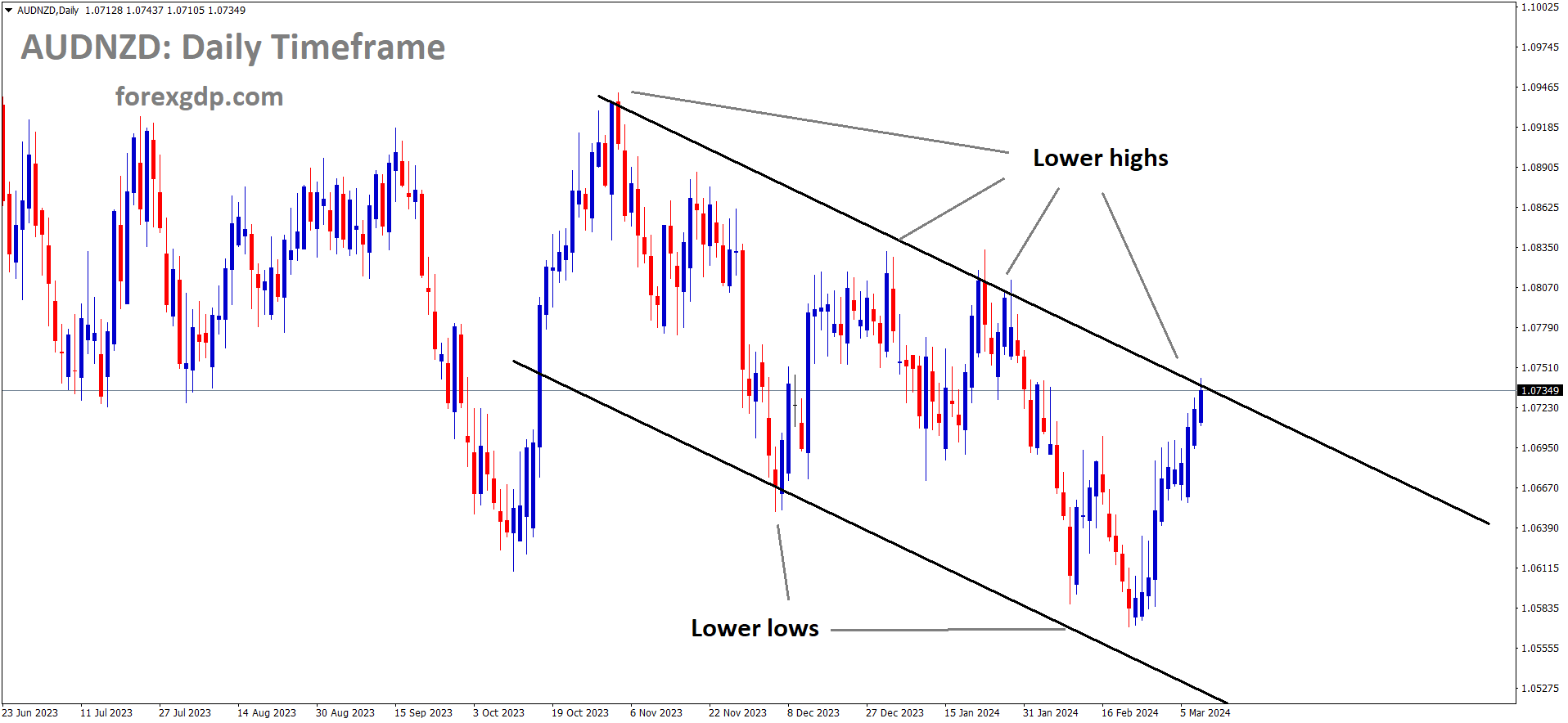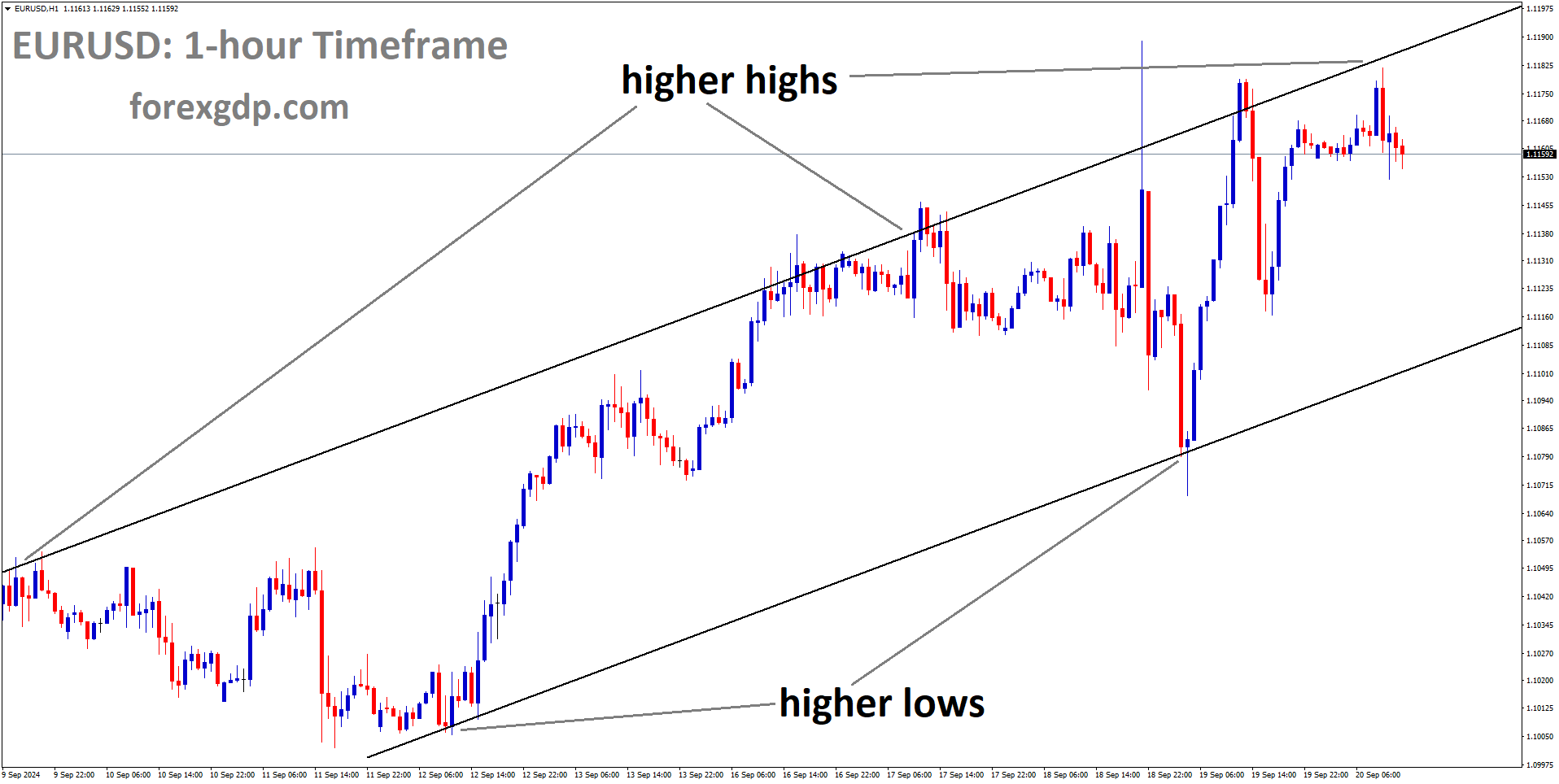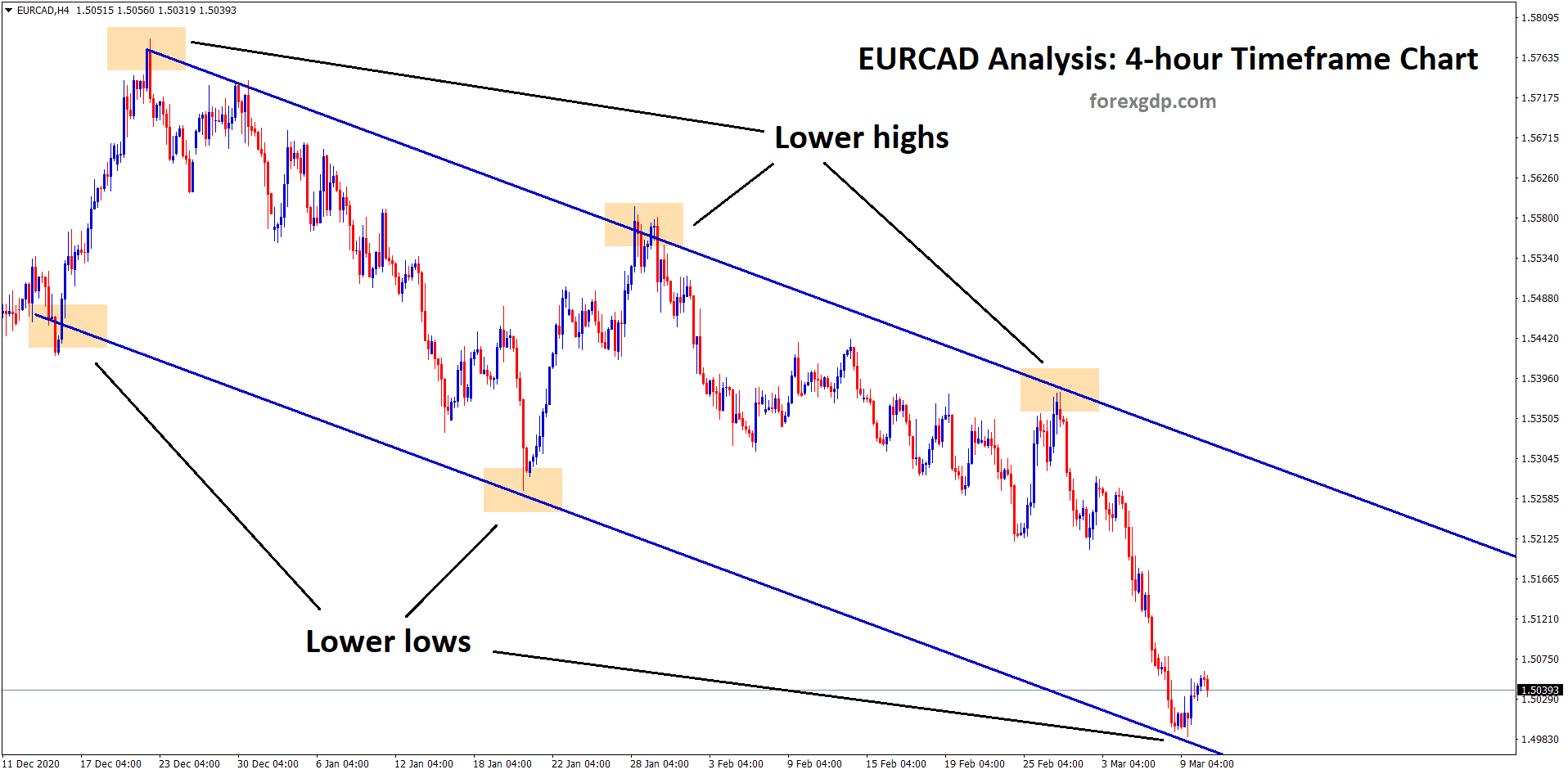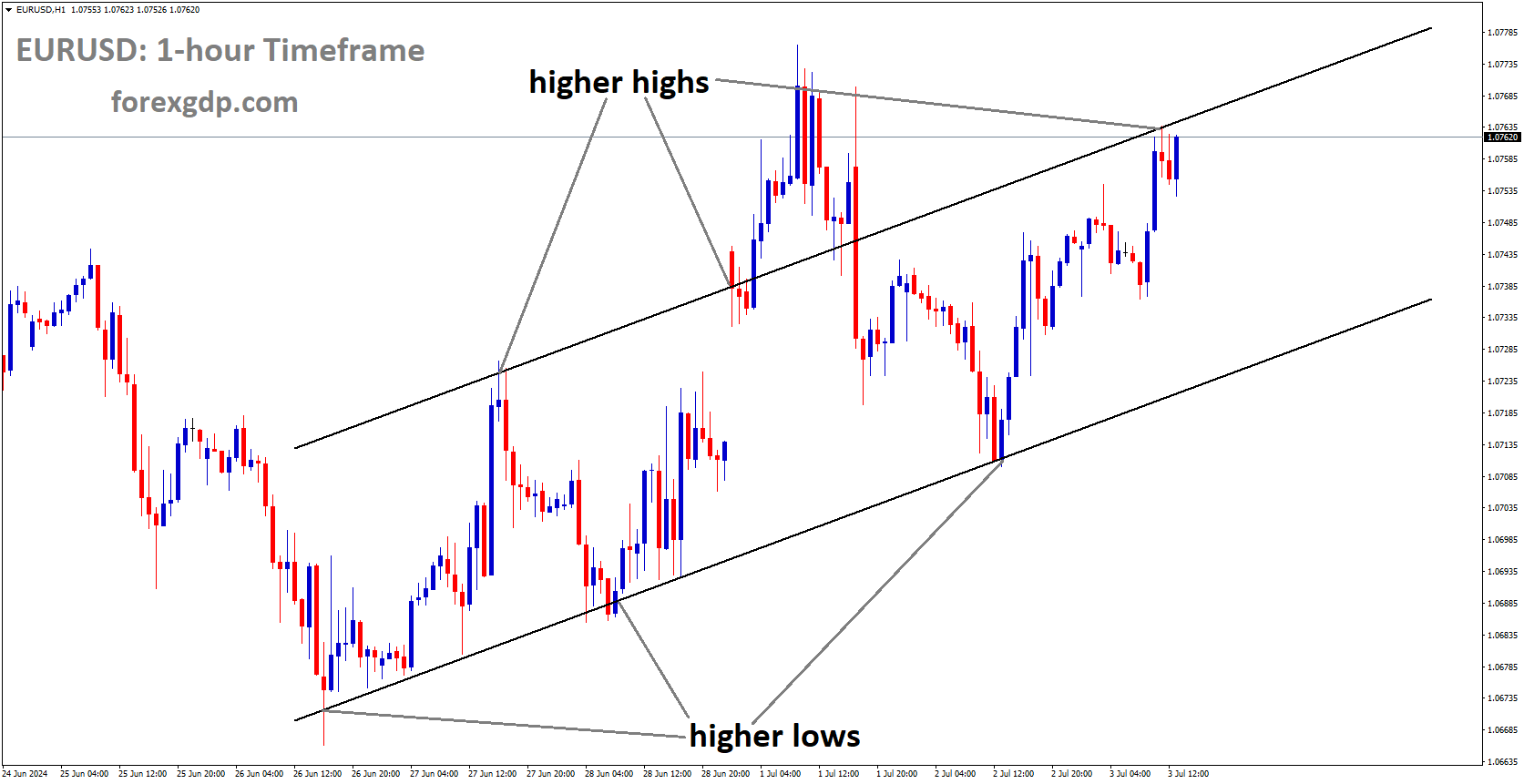XAUUSD Gold price is moving in an Ascending channel and the market has reached the higher high area of the channel
GOLD – Price Forecast: XAU/USD Extends Rally Above $2,160, Investors Await US NFP Data
Gold prices are continue in upside bias after the Chinese investors buying Gold as safe option after the realestate andStock markets tumbled in China. Middle east tensions adding support for Gold prices to stronger upside.
A weaker US Dollar (USD) and declining US Treasury bond yields are supporting the gold price. Expectations of the first rate cut by the Federal Reserve (Fed) in the June meeting are boosting gold demand. Dovish comments from central bank policymakers, including Fed Chair Jerome Powell, create a tailwind for the yellow metal. Powell mentioned that the Fed is close to gaining confidence in reaching its 2% inflation target, signaling potential interest rate cuts. Investors await the US Nonfarm Payrolls (NFP) data for further direction, with a forecast of 200,000 jobs added. Stronger-than-expected data could strengthen the US Dollar, impacting gold prices.
Meanwhile, ECB President Christine Lagarde suggested potential policy easing in the June meeting. The ECB, maintaining its benchmark rate at 4.0% in March, lowered its 2024 inflation forecast from 2.7% to 2.3%, hinting at possible rate cuts ahead.
Chinese investors turned to gold amid challenges in the property and stock markets. Geopolitical tensions in the Middle East also contribute to demand for traditional safe-haven assets.
Gold traders are closely monitoring Eurozone Gross Domestic Product (GDP) for the fourth quarter and upcoming US labor market data, including Nonfarm Payrolls, Unemployment Rate, and Average Hourly Earnings, to identify trading opportunities around the gold price.
EURUSD – German Industrial Production Up 1.0% MoM in January, Surpassing 0.6% Expected
The German industrial production came at 1.0% up in January month versus 0.60% expected and overcome the reading of 2.0% decline in December month.
EURUSD is moving in an ascending channel and the market has reached the higher high area of the channel
In January, Germany’s industrial sector rebounded, registering a 1.0% MoM growth, according to data from Destatis.
This exceeded expectations of 0.6%, marking a positive turnaround from December’s 2.0% decline. However, on an annual basis, German Industrial Production fell by 5.5% compared to December’s 3.0% decline.
USD INDEX – Biden’s SOTU: US Inflation Hits World’s Lowest at 3%, Declining
US President Joe biden addressed before congress union members meet outcome is inflation is down to 3% it is lowest in the world, We aids more to Israel to support Gaza civilians, we must stop this war and speech is going in the past 6 weeks.
USD Index has broken the Ascending channel in downside
President Biden’s Friday State of the Union (SOTU) highlights:
– Inflation hits a world-low of 3%, showing a downward trend.
– Ensuring a soft landing for the economy.
– Urgent call for increased aid to Gaza by Israel, safeguarding humanitarian workers.
– Tirelessly working towards a six-week ceasefire.
USDCHF – Slides Below 0.8800, Focus on US NFP Data
The Swiss Unemployment rate came at 2.4% versus 2.5% expected as per the data showed by (SECO) The State of Secretariat for economy affairs. The inflation reading is lower than expected in last week reading, Now unemployment rate is lowered. SNB is more like to cut the rates at this month meeting is more expected from Economists side.
USDCHF is moving in an Ascending channel and the market has reached the higher low area of the channel
Fed Chair Powell restated on Thursday his anticipation of interest rate cuts in 2024, contingent on favorable economic data. Confidence in inflation returning to 2% is crucial for such cuts. US labor market data later in the day will impact economic assessments and market sentiment, with stronger-than-expected data potentially boosting the USD/CHF pair.
Meanwhile, Switzerland’s February Unemployment Rate improved to 2.4%, while lower inflation may lead to expectations of a Swiss National Bank interest rate cut later this month, currently at 1.75% since June 2023. All eyes are on the US Nonfarm Payrolls for February, with a forecast of 200K job additions, steady Unemployment Rate at 3.7%, and an expected drop in Average Hourly Earnings to 0.2% MoM.
EURCHF – ECB’s Villeroy: Rate Cut in Spring ‘Very Likely’
ECB Governing council member Francois Villeroy De halhau said Rate cuts is most probably in April to June month meetings. Spring months is most expected rate cuts from ECB, due to lower inflation in Euro area.
EURCHF is moving in an Ascending channel and the market has reached the higher low area of the channel
ECB’s Villeroy: ‘Very Likely’ Rate Cut in Spring, Spanning April to June.
EURJPY – Suzuki: Rising rates pose risk to Japan’s debt
The Japanese Finance minister Shunuchi Suzuki said rate hikes will impact the Japan’s debt, we have to maintain Fiscal health more than primary budget balance.
EURJPY is moving in an Ascending channel and the market has reached the higher low area of the channel
Japanese Finance Minister Shunichi Suzuki expressed concerns on Friday regarding the potential impact of rising interest rates on Japan’s debt. He stated, “There’s a risk that rising interest rates could pressure Japan’s debt.” Suzuki clarified that he is not currently at a stage where he can discuss fiscal targets beyond the primary budget balance.
Furthermore, he emphasized the importance of ongoing efforts to sustain fiscal health, highlighting the need for persistent measures in this regard.
EURNZD – Surges on Upbeat Chinese Trade Figures
NZ Dollar strengthened after the China trade surplus data for the month of February came at $125.16 Billion. This will boost NZ exports to China, mainly Dairy products. Chinese importers will buy more NZ currency for imports. This will boost NZ Currency in the international market.
EURNZD is moving in the Descending triangle pattern and the market has falling from the lower high area of the pattern
New Zealand Dollar Rises on Surprising Chinese Trade Data
The New Zealand Dollar experienced a surge following the release of unexpected Chinese Trade Balance data. The trade surplus for February rose to $125.16 billion, surpassing economists’ expectations of $103.70 billion and exceeding the previous month’s figure of $75.34 billion. This robust surplus indicates economic strength in China, suggesting increased prosperity and higher demand for New Zealand exports, particularly dairy products. Consequently, there is a potential rise in demand for the New Zealand Dollar from Chinese importers.
Looking ahead, the New Zealand Dollar faces no major upcoming releases. However, the NZD/USD may experience volatility after the release of Nonfarm Payrolls (NFP) on Friday and during the second day of Federal Reserve (Fed) Chairman Jerome Powell’s testimony to lawmakers on Thursday. A lower-than-expected NFP result could align with the narrative of the Fed accelerating interest rate cuts for a smoother economic transition, putting downward pressure on the USD and supporting further gains for the NZD/USD, as lower interest rates become less appealing to investors.
GBPUSD – Hits New Highs in 2024, Surpassing 1.2800 Mark Prior to US NFP Data
The investors felt that the rate cuts are mostly done by FED side first and then followed by the Bank of England. So Rate cuts from BoE is mostly in August month. So UK Pound is moving stronger against USD.
GBPUSD has broken the Descending channel in upside
Federal Reserve Chair Jerome Powell presented the Monetary Policy Report and answered questions before the Senate Banking Committee on Thursday. Powell suggested that interest rate cuts might be on the horizon if inflation signals align. While Powell didn’t provide a precise timeline, he hinted that the day for rate cuts could be approaching. Investors anticipate the first cut to occur in June, with a total of four reductions, amounting to a full percentage point, by the end of 2024.
Conversely, financial markets are expecting the Bank of England (BoE) to follow the Fed’s lead in lowering interest rates. This expectation bolsters the Pound Sterling (GBP) and provides momentum for the GBP/USD pair. Investors are looking towards the August meeting for potential easing by the BoE. However, BoE policymakers are likely to wait for more evidence of inflation before making any decisions.
Looking ahead, traders will closely monitor the US February Nonfarm Payrolls, Unemployment Rate, and Average Hourly Earnings, scheduled for release on Friday. These events have the potential to induce market volatility. Market participants will analyze the data for insights and trading opportunities surrounding the GBP/USD pair.
GBPCAD – Canada Employment Outlook: Projections from Top Banks, Anticipating a Slight Increase in Unemployment Rate
Canadian Unemployment rate is expected to come at 5.8% and 20K jobs is expected in February month. Canadian Dollar is moving higher after the Bank of Canada hold the rates this week.
GBPCAD is moving in an Ascending channel and the market has reached the higher low area of the channel
Job Market Outlook for Canada: Analysts Predict Slower Job Growth and Slight Rise in Unemployment Rate
Economists are forecasting that the Canadian job market will show a modest increase in February, with estimates ranging from 5,000 to 45,000 additional jobs. Following January’s robust gain of 37,300 jobs, the unemployment rate is expected to edge higher, reaching around 5.8% or 5.9%.
RBC Economics anticipates a gain of 10,000 jobs, not sufficient to prevent a rise in the unemployment rate to 5.9%, reflecting a persistent gap between hiring demand and the growing labor force. Although January’s labor market data exceeded expectations, signaling strong wage growth, the trend of lower job openings continues, indicating slowing labor demand.
NBF predicts a cooling in job creation to 15,000 in February, a reflection of an economy operating below its potential. This gain, coupled with an expanding labor force and an unchanged participation rate, is expected to result in a two-tenths increase in the unemployment rate to 5.9%.
TDS forecasts a slower job growth of 5,000 in February, with a corresponding increase in the unemployment rate to 5.9%. Wage growth for permanent workers is anticipated to decelerate to 5.1% year on year.
CIBC expects a weaker gain of 20,000 jobs in February, below the average pace of population growth, potentially pushing the unemployment rate back up to 5.8%. Wage growth for permanent employees may decelerate to 5.0%.
Citi projects another solid increase of 45,000 jobs in February, following the strong performance in January. Despite potential seasonal issues impacting January figures, February’s employment growth is expected to be substantial, leading to a slight rebound in the unemployment rate to 5.8%. Wage growth is forecasted to moderate slightly to 5.1% year on year.
AUDNZD – AUD Gains with ASX 200 Boost, USD Steady Before US NFP
The Commerzbank economists said RBA can do rate cuts only when the inflation rate going down as they expected. Once slowdown and recession signalling in the economy then monetary policy changes will be decided by RBA. Recent GDP, Tradebalance, EXIM data is lower than expected is showing slowdown in Australian Economy.
AUDNZD is moving in the Descending channel and the market has reached the lower high area of the channel
AUD Rises for Third Consecutive Day Amid Potential USD Decline and Dovish Fed Commentary
The Australian Dollar (AUD) continued its winning streak for a third consecutive session on Friday, driven by the possibility of the US Dollar (USD) moving downward. Federal Reserve (Fed) Chair Jerome Powell, in his testimony before the US Congress, hinted at potential interest rate cuts sometime this year, boosting demand for the AUD. The positive momentum was further fueled by improved market sentiment, driven by a surge in equity markets, particularly the S&P/ASX 200 Index reaching new record highs.
Despite concerns about the Australian domestic economy’s expansion falling short of expectations and a Trade Balance surplus below expectations, the Australian market remains resilient. Economic indicators suggest a case for the Reserve Bank of Australia (RBA) to consider rate cuts soon. Speculation indicates possible RBA rate cuts starting as early as August, with a total easing of 45 basis points anticipated for 2024.
In economic news, the Australian Trade Balance (MoM) showed an increased surplus in February, while GDP growth for Q4 2023 slightly fell short of expectations. Various economic indicators, including Imports, Exports, GDP (YoY), AiG Industry Index, Judo Bank Services PMI, and the Current Account Balance, provide insights into the Australian economic landscape.
Commerzbank economists anticipate that the RBA will delay rate cuts, supporting the AUD for the time being. Chinese Trade Balance USD, Cleveland Fed President Loretta Mester’s remarks on inflation concerns, and insights from former New York Fed economist Steven Friedman add further context to the economic landscape.
Additionally, US economic indicators, such as Initial Jobless Claims, Nonfarm Productivity, ADP Employment Change, JOLTS Job Openings, ISM Services PMI, Factory Orders, S&P Global Composite PMI, and ISM Manufacturing PMI, provide a comprehensive view of the US economic situation.
Market attention is on the US Nonfarm Payrolls (NFP) data, with the AUD poised to respond to fresh impetus based on this employment report. The likelihood of rate cuts in the spring, according to ECB’s Villeroy, adds another layer of interest in the global economic landscape.
Don’t trade all the time, trade forex only at the confirmed trade setups.
Get more confirmed trade setups here: forexgdp.com/buy/

